 My husband loves hot condiments. So this year I experimented with hot pepper jam. This stuff is addictive. I warn you now. And easy. Really easy. You can find recipes online, but I designed this to be made in just a few hours, and to make about 16 pints. I cut back on the sugar a bit (still takes a LOT, to set the pectin), but it still is sweet enough. It won't set up as thick, but I think the texture is just fine. It sticks to the cracker, and doesn't drip too badly. 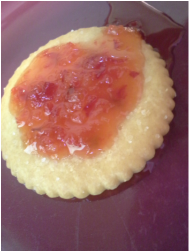 Can't wait to try it with cream cheese! Anyway, enjoy! Let me know how it works for you! Recipe: Hot Pepper Jam
1 peck Hot Banana Peppers 1 peck Sweet Red Italian Frying Peppers 2 Tbsp Hot Red Pepper flakes 10 cups Apple Cider Vinegar 1 cup powdered pectin 15 cups white sugar
Enjoy!  Are you a blueberry lover? I received a call from a reader asking for a blueberry pie recipe - specifically one in which the berries do NOT need to be cooked or thickened beforehand. As with all baking queries, my first thought was to call my mother!  With all the cooking I do, one aspect of the kitchen that I have in NO WAY mastered is pie. Pie crust defies me. I have a million 'perfect' crust recipes. It doesn't matter. Pie is my nemesis. BUT, I have my mother's secret weapon. Her name is Fannie. Fannie Farmer, to be exact. Everyone, say hello to Fannie Farmer. The best cookbook ever compiled. 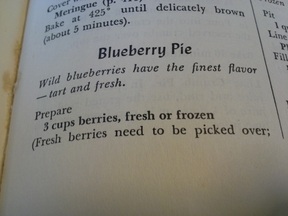 So, dear reader, here is your recipe - Blueberry Pie according to Fannie. I didn't even transcribe it. The old parchment of this book lends to great pictures. And don't you just love the old-fashioned font?  Happy pie making!  Yes, you read that correctly. Earlier this year, we were 'gifted' with 60+ cabbage plant slips. They ALL grew. So now I'm trying to figure out what to DO with them. We like sauerkraut, maybe once every few months. We like coleslaw, about 1/4 cup every few weeks. We even like fried cabbage with apples and onions. Twice. Each year. Can you see my dilemma? We just aren't huge cabbage eaters. But we also don't want to waste food. I mean, if the zombie apocalypse happens this winter, we want to be prepared, right? Here are some of the suggestions I've received on my facebook page, when I posted a huge 'HELP!' status: Kim Chee Cabbage Rolls Sauerkraut Dehydrate (THEN what?) Kapusta soup (yes, that's a real food) Golumkis (yep. real food. recipe here) Fried Cabbage & Noodles Cabbage Pie Stuffed Cabbage Poor Man's Cabbage & Corned Beef A pretty impressive list. I have decided to make some frozen coleslaw. I like coleslaw. I envision sharing a 'summer' meal in the middle of December with a family - complete with local hot dogs and local potato salad. Then again, they might look at me funny and remind me that they were happy to see cabbage go out of season... Here is the recipe I am using, just in case you too become overrun with cabbage: Frozen Coleslaw Frozen Cole Slaw
Ingredients
Mix Vinegar, water, sugar and Celery seed and boil 1 minute. Let stand until lukewarm, and then pour over cabbage mixture and freeze. Credit: Copy Kat @ CopyKat.com 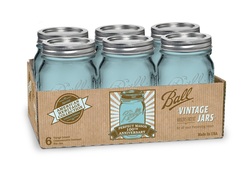 So here's the thing. I've been neglecting you lately. And I'm sorry. I have so appreciated the support and care from my online friends and family as my own family navigated some pretty tough times this past year. You know those times when you wonder how anything will ever be 'normal' again? *nodding* Yup, that's been my life this past year. Luckily for me, I have God on my side. I finally stepped back, shut up, and got out of the way. Whoa baby. (Can I just say, if God's been trying to get your attention on something, don't try to dodge and weave Him. 'Cuz friend, He loves you too much to let you go. He's gonna come after you with all the love in his arsenal.) So things got a bit hairy around here. I stopped writing much, certainly not regularly. But you hung in there with me. Cards, phone calls, private messages, texts - I was so blessed with your concern and care! Here's my way of saying 'thank you', and let's get this blog rolling again! Until July 23rd, head over to my facebook page and submit a real food recipe. The ones we like - with local, seasonal ingredients AND that our families enjoy. Then share the RosalynPricEnglish.com facebook page with your friends! You'll be automatically entered into the contest to win.... *drumroll* A case of those fantastic 'new' vintage blue Ball jars! Plus, I'm going to part with one of my super hard-to-find green vintage Ball jars. I'll ship it anywhere in the contiguous United States. (Live outside that region? If you get chosen, you'll get a $20 gift card to Amazon. ) A random-number generator will select a number - each entry will receive a number that I'll private message to you. One entry per person, but I'd love to see more than one of your recipes. In August, I'll compile all your recipes, and create an e-book! You can download it and print it, or you can use it right from your computer or tablet. Stay tuned for more, and welcome back! (To you AND me!) Blessings, Rosalyn February???!!! I haven't updated since February? Wow.
Well, my apologies. Let me first catch you up on the pig adventure. Unfortunately, the person with whom I was working with to raise the pigs decided they wanted to take their pigs home. (We'd parted ways on a separate business venture, and that didn't sit well with them. So, they picked up their pigs and went to play alone at home.) This was actually a blessing in disguise, as the pain in my shoulder had been increasing by the day, and it was becoming too much for me. One pig was much easier on my aching body. We fed the pig out to about 200 lbs on whey and hay, and at that point introduced pig feed from a local mill. Two and a half bags of feed later, she had put on another 60 lbs and was ready for the butcher. We brought home 230 lbs of meat, and more in scrapple, liverwurst and lard. The meat is flavorful and dense, but not tough or gamey. We've decided that we'll do more 'winter pigs' in the future, as we are super happy with the cost (minimal) and the quality. Knowing how factory farmed pork is raised, and pork that is raised on local farms but on concrete pads, I am confident that a happy pig produces better meat. Our pig was handled gently, humanely and left to be 'a pig' while she was raised out. Even her loading onto the truck was done so gently that there was barely a grunt out of her. According to my online mentor and hero, Walter Jefferies, that makes for the best pork. Our adventure was a success, even better it tasted good. Pig had a good life (we called her pig), I learned a lot, and have yet another 'I can feed my family' experience under my belt. Want to know more about raising pigs? Follow Walter. He's king. Read more at Sugar Mountain Farm.  Fresh hay, yum! It's been a few weeks since I've posted last, busy and distracted from my pig posting. During that time I have been experiencing the joy of livestock in the winter. I need to say though, even on the coldest mornings, I enjoy getting outside and checking on the animals. That said, the pigs are growing well. My husband, who is an old-time conventional farmer, isn't as comfortable with these newfangled lean, forage-based pigs. Most butchering hogs are raised on corn and soy - super fat and super stout. **Warning, this post is a bit long and technical, written for my readers who are considering doing this themselves. Sorry if it gets boring.**  Dirty little pig! These pigs are tall and lean, and eating like crazy! On average, they are eating a half of bale of hay a day, some times more. We are feeding high quality alfalfa, and if we didn't have this hay in storage, I would be purchasing round bales for the pigs. I supplement their hay with cheap vegetable protein sources like rice and beans (bought for super cheap prices at a local scratch and dent and I cook up a pot for each meal), beans, peas and lentils - whatever I can find that is inexpensive and 'clean'. I have so far been able to stay away from conventional or organic pig feed - which is mainly corn and soy. I did get 1000lbs of whole grain oat-based feed, and have it ground with alfalfa for a custom, protein-packed, low-corn/soy, pig feed. I mix that with hot water to make a mush. They gulp that right down. They have a deep bed (about 4 feet) of mulched hay in the shed, and dig down to the bottom every day, rooting around and snuggling under the mulch. On the warmer days, they head out into the paddock to root around and run around, but mostly they stay in the shed.  Chickens sharing pig paddock Feeding the whey has been problematic, because I do not have a heated storage shed for the barrels. In addition to the problem of freezing whey, I have been needing to carry the buckets up myself, and my right shoulder can't handle the weight of the buckets. Added to that, the pigs don't like freezing cold whey or water (who WOULD in winter time?!), and the challenge of whey has me scratching my head. I still do get them whey, but I pour out each barrel into 5 gallon buckets, bring the frozen buckets in the house to thaw out, then heat the whey on the stove to room temperature so they will drink it.  Loving the hay! The lesson here is this: INFRASTRUCTURE. If my infrastructure had been well planned and executed, my time would be put to much better use. Cooking for pigs twice a day was not what I had envisioned. Looking back, I had great ideas, but not the skill or help to execute them. To do this efficiently, I need a pole shed with at least one room that I can keep at 40 degrees. (The whey won't freeze above 38 degrees) A 250 gallon tank, with a spigot to a tank outside would be a great solution. I'd put the tank on a cement pad to keep it out of the mud. My water tank and my whey tank would be on the back side of my pole shed, under a roof, on a cement pad. The actual pig enclosures would be out in the woods, close enough to take out round bales, but far enough from the building to keep them from making a mess near the shed. As I said, I've been learning a lot. I am excited to get the pigs raised and out of here, but am hoping to create enough infrastructure to raise them each winter. The plus side to raising hogs in the winter is the lack of flies, and no smell. A great plus for a small landholder who has neighbors. We are about 3 months from butchering, and looking forward to our healthy, lean pork! 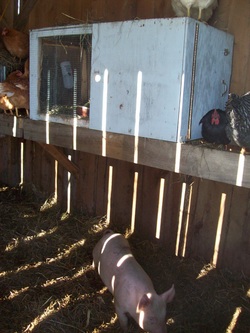 Rabbits, Pigs, Chickens... OH MY! At the conclusion of the last pig-raising post about fencing, I asked the question: "Will non-heritage pigs actually eat hay?" As you can see from the pictures above, the answer is 'YES!'. I can't tell you how relieved I felt to see that pig eating the hay. As with every adventure, however, there have been a few learning experiences as well in the past few weeks. Unfortunately, one of the downsides to raising pigs in the winter is that the whey is not as readily available. During the spring, summer and early fall months, our local dairy is very busy making cheese. (As an aside, as part of this experience, I've learned that they actually make custom batches of cheese, using customers' milk. Neat.) However, in the winter, the cheese-making tapers off a bit. I learned this after showing up with two newly-acquired 50 gallon food-grade drums, ready to collect whey. Someone had gotten there before me, and cleaned out the tank for THEIR pigs, so mine were out of luck. Thinking quickly, I reasoned that we could increase their feed and supplement with a product called 'milk replacer', basically a dried milk that cattle-owners use for calves that need to be bottle or pail-fed. This is a VERY inferior product to whey, with the biggest drawback being that it is neither cultured nor raw, nor does it contain the high-protein content of the whey. As an upside, it does contain more fat... The other downside to this plan was that pigs do not digest whole grains well, so while it's a nice treat, they do not derive the same nutrition they would from whey and high-quality hay. So increasing the grain presented it's own problems. Since I was away for a week, I needed to let this experiment play out without the added benefit of being there. Yes, we all know where is this going. Down hill... That's when tragedy struck. Murder. Mayhem. A complete breakdown of the happy barn community structure. The pigs killed and ate a chicken. Don't ask me how I know. Just trust me on this one. You don't need to see the outline on the floor or the other forensic evidence. All you really need to know is that Bob, our polish crested hen, has gone to meet the big chicken in the sky. After a full investigation, with none of the pigs willing to reveal the true culprit (Which, as they argued, makes sense, as they may be pigs, but they are NOT rats.) I did a lot of research and have discovered two schools of thought on this omnivores' dilemma. I've discovered two schools of thought: 1. The pigs were bored; 2. The pigs were low on protein. I'm inclined to believe a mixture of the two. So here's my solution: I broke apart another huge round bale of hay, scattering it around the snowy ground. This gives them more space to walk around outside, off the snow. By moving the bale, I uncovered a nice patch of dirt for rooting in. It also gives them some fresh hay to eat. I wish I had had a camera when I was unrolling the bale of hay. The pigs were little puppies with a new toy. They were racing around, grabbing mouthfuls and shaking their heads like puppies with a stuffed animal. Cute pigs. I also bought a bag of unshelled peanuts. After sprinkling them all over the floor of the shed, they went crazy looking for the peanuts. I am hoping that this will cut down the boredom. (I'll sprinkle a few handfuls each day until this snow melts.) I've also increased the milk replacer, and will be making up yogurt buckets. To make a 'Yogurt Bucket', I'll fill a bucket with the milk replacer and add some yogurt, and place it down by the woodstove to stay warm and culture. This will help them stay healthy while they are on the milk replacer. Luckily for me, the dairy now knows that I will come and pick up whey at a moments notice, and have put me on the short list. (Another reason to get on good terms with local farmers!) So, this is a rather long post. We've covered eating habits, criminal activity, and more home-cooking for pigs. Is all the work worth it? I'll admit, some days it's daunting. But it's winter. What else do I have to do? AND, don't forget, in the spring I will have fresh pork as well as a newly plowed garden!  As I spent my Christmas Eve stringing wire, untangling rope fencing, and stepping fence posts into the hardening winter ground, I forgot for a few moments that I don't consider myself a farmer. I forgot that I am a business woman and that I love my high-heel boots, lots of bling and sassy hair styles. Instead, my mind was focused on knowing that as I worked on my little pigs' pasture, I was again acquiring new skills. With each experiment I undertake here on our little homestead, my repertoire grows. Each year, I discover new ways to feed my family, and families in our community. (Big shout out to Mother Earth News for this month's article on raising pastured pigs!) 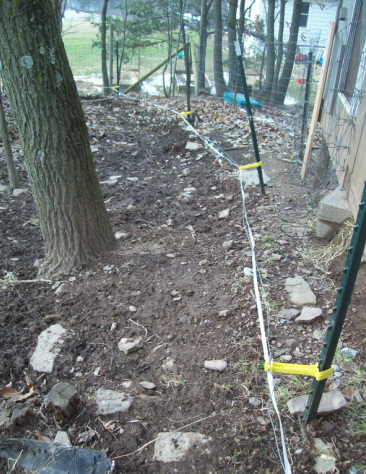 Today's blog post will be about fencing. I trained the pigs to the fence by first fencing in a small area. Down the center of the paddock, I cordoned off a section with hog panels (about 1/3 of the paddock), and then strung the fencing around the bottom (about 6 inches off the ground). I used a five-acre horse fencer, which gives LOTS of zap for this small of an area. I wondered why we had one that snaps (goes on and off) and was reminded that if it was a continuous flow of energy the pigs would become 'stuck' if they touched it. (Silly of me, but I really didn't know that.) I used a smooth 20 gauge wire and then strung white horse tape fence on top of it for visibility. (Something I gleaned from the Women in Agriculture networking day I attended the week earlier.)  Day one of having the fence on, I found that the pigs tested each side a few times, but eventually ignored it. (However, I will say that as time as gone on, I hear squeals regularly, so they ARE testing it.) I did find that the fence needed to be higher in some places - like in front of the gate where the ground is soft and just right for rooting around. Many times I would go up to the shed to find that they had pushed the dirt up and over the fence, which shorted out the entire area. Not good. I had considered the possibility that the pigs might break through the fencing at some point, so you'll notice that the 'hot' wire is actually inside of our fenced paddock area. I'm doing this for two reasons, 1. the paddock is already attached to the shed, and 2. while the pigs are training on the fence, I want them contained if they happen to break through the hot wire.  Once the pigs were trained on the small area, I had planned on putting them out into the woods. But after attending a Women in Agriculture symposium, I learned that it's best to finish the pigs on the acorns in our oak grove ('finish' refers to the last month or two before butchering). After seeing what an amazing job of plowing they were doing in the small paddock area, I decided to let them have the entire paddock for the winter. I reasoned that this will give me a prepared patch where I will plant our garden next year. (Plus side to that - it's already fenced in, which will keep it safe from chickens and ducks.)  You'll notice that even as I gave them the entire paddock, I kept the hog panels in place, and bent one to the side. This gives me a 'gate' - I also kept the electric fencing in place down the middle so that I can use a fencing handle to pull it back across if I want to - that way I can put them back into the smaller area if I need to. They are very happy with their new area. Within seconds of being turned out, they were munching on weeds and grass. Last I looked, they were rooting under the chestnut trees - I'm sure they are finding some tasty treats there! Now, my biggest concern was this: will generic white pigs eat hay on their own? (These are berkshire crosses, not heritage pigs bred to be out on pasture.) Once the snow flies, there won't be much in the way of grass out there. Will they eat hay? Will they have to be taught? Will I end up having to buy feed? Remember, my goal is pastured pigs that are fed a diet that is primarily dairy and hay. Stay tuned for that episode, coming next week.  www.michaelsprovision.com Portuguese Kale Soup is a fond memory for me. As a child, my mother would start this soup early in the day and finish cooking it on the woodstove. We would walk into the door after school, smell this soup and run for bowls. I have made many versions of this soup over the years, but have come to the conclusion that simple is better. And this recipe doesn't get much more economical or simple. The only ingredient you may be challenged to find is the Portuguese sausages: linguica and chourico. I buy mine from a store in Fall River, MA called Michaels Provision Company. Lucky for me, Micheals also ships their meat. If you can't find linguica or chourico, you can use plain ground pork, and add 2 tbsp of smoke paprika to your soup. This will give you the flavor/color. Portuguese Kale Soup 1 cup dried dark red kidney beans 1 cup dried navy beans 3 quarts homemade stock or water 1/2 pound linguicia 1/2 pound chourico 1 tsp garlic powder 1 tsp salt 4 cups fresh, chopped kale (or frozen) 2 cups fresh potatoes (Cut as you wish. I like mine quartered, skin on.) 2 cups fresh carrots (Optional. My mom hate carrots in this soup.) 1 cup tomato juice The night before, rinse the beans, and add to slow cooker with the stock. Turn to high and go to bed. (For me, I usually am doing this at 10pm, back to it at 8am.) In the morning, cut up the sausage and cook in a frying pan for a few minutes. (If you are using regular pork sausage, cook completely and drain before adding to slowcooker) Add cooked sausage, kale, tomato juice, potatoes, garlic powder and salt. If I forgot anything, add that too. Cook on high. In about four hours your soup will be ready! If you need to leave it for the day, cook it on low. When you are ready to serve the soup, crumble some kale in the bottom of the bowl (I keep frozen kale on hand just for this!) and pour the hot soup on top. While you are waiting for the soup to cool down, the kale is steamed. Stir and enjoy! |
Archives
August 2015
Categories
All
|

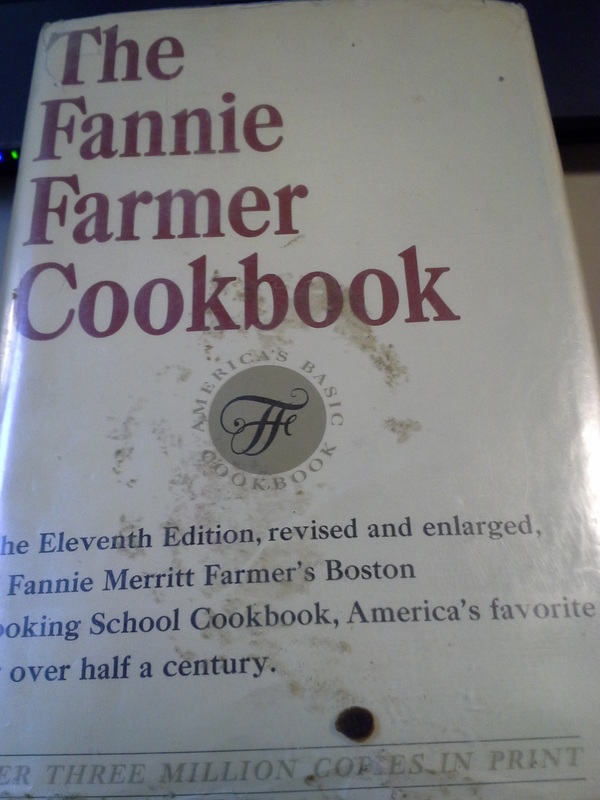


 RSS Feed
RSS Feed